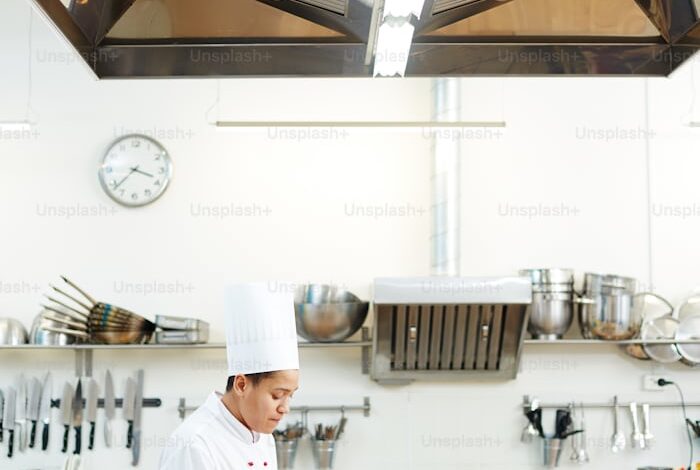Designing Restaurant Kitchens for Culinary Excellence

A well-designed kitchen is the heartbeat that keeps everything running smoothly. Imagine a symphony where each chef and kitchen staff moves harmoniously, creating culinary masterpieces without missing a beat. An efficient kitchen layout not only enhances productivity but also ensures safety and satisfaction for everyone involved. Whether you’re a seasoned restaurateur or an aspiring one, understanding the nuances of kitchen design can be your secret ingredient to success.
The Role of Kitchen Design in Restaurant Efficiency
When it comes to maximizing efficiency, the design of a restaurant kitchen is paramount. A thoughtfully laid-out kitchen can significantly impact the speed and quality of service. Imagine a space where chefs can seamlessly transition from prep to plating, minimizing wasted steps and time. By prioritizing efficient design from the outset, restaurant owners can reduce bottlenecks, improve communication, and ultimately enhance the dining experience for patrons.
A well-organized kitchen isn’t just about aesthetics; it’s about functionality. In the fast-paced environment of a restaurant, every second counts. With a strategic layout, chefs can easily access ingredients and equipment, reducing the time spent searching for essential items. This, in turn, allows the kitchen brigade to focus on what they do best—creating unforgettable dishes that keep customers coming back for more.
Additionally, a well-designed kitchen fosters a positive work environment. Chefs and staff are less likely to experience fatigue or frustration when everything they need is within arm’s reach. This not only boosts morale but also minimizes the risk of accidents, creating a safer space for everyone. Ultimately, investing in an efficient kitchen design pays dividends in both productivity and the overall atmosphere of the restaurant.
Key Factors in Kitchen Layout: Flow, Safety, and Ergonomics
The foundation of an efficient kitchen lies in three key factors: flow, safety, and ergonomics. Each element plays a crucial role in creating a workspace that maximizes productivity while minimizing risks.
Flow refers to the seamless movement of both people and products through the kitchen. A well-designed layout ensures that chefs can move effortlessly from one station to another, minimizing unnecessary steps. This not only speeds up food preparation but also reduces the chances of collisions and accidents. By strategically placing equipment and workstations, restaurant owners can create a harmonious flow that enhances efficiency.
Safety is paramount in any kitchen environment. From sharp knives to hot surfaces, there are numerous potential hazards. A good kitchen design incorporates safety measures such as non-slip flooring, adequate ventilation, and strategically placed fire extinguishers. Additionally, maintaining clear pathways and ample space between stations helps prevent accidents and ensures a secure working environment for all staff members.
Ergonomics is the science of designing workspaces that fit the human body and its movements. In a kitchen, this means arranging equipment and workstations at appropriate heights to minimize strain and fatigue. Ergonomic design reduces the risk of repetitive strain injuries and promotes overall well-being. By prioritizing ergonomics, restaurants can ensure that their staff remains comfortable and productive throughout long shifts.
Exploring Different Kitchen Layouts: Assembly Line, Island, and Zone
Choosing the right kitchen layout is a critical decision that can greatly impact the efficiency of a restaurant. There are several common layouts, each with its advantages and considerations.
The assembly line layout is ideal for restaurants with high-volume production, such as fast-food establishments. In this setup, stations are arranged linearly, allowing for a streamlined workflow. Ingredients move along the line, with each station responsible for a specific task. This layout is efficient for producing large quantities of similar dishes quickly.
The island layout features a central island that serves as the main hub for food preparation. Surrounding this island are various stations, each dedicated to a specific task. This layout encourages collaboration and communication among staff, making it suitable for open kitchens where chefs interact with guests. The island layout is versatile and works well for restaurants offering diverse menus.
The zone layout divides the kitchen into distinct zones, each dedicated to a specific task (e.g., prep, cooking, plating). This layout is well-suited for restaurants with a wide variety of menu items, as it allows chefs to focus on their specific areas of expertise. The zone layout promotes organization and minimizes cross-contamination, making it a popular choice for many modern kitchens.
Harnessing the Power of Technology in Kitchen Efficiency
In the digital age, technology is revolutionizing restaurant kitchens, enhancing efficiency, and elevating the dining experience.
One innovative advancement is the integration of smart kitchen appliances. From programmable ovens to temperature-controlled refrigerators, these devices streamline cooking processes and ensure consistency. Smart appliances can be controlled remotely, allowing chefs to monitor and adjust settings from a distance, ultimately saving time and reducing energy consumption.
Thermal fluid systems are another technological marvel that can significantly impact kitchen efficiency. Unlike traditional methods, thermal fluid heating systems provide precise temperature control, ensuring even cooking and reducing the risk of overcooking or burning. This level of precision is especially valuable in high-end kitchens, where perfection is key.
Additionally, kitchen management software offers powerful tools for inventory tracking, order processing, and staff scheduling. By automating these tasks, restaurants can reduce human error, optimize resource allocation, and ultimately improve overall efficiency. Kitchen technology not only enhances productivity but also empowers chefs to focus on creativity and innovation, resulting in exceptional culinary experiences for patrons.
Future Trends in Restaurant Kitchen Design
The future of restaurant kitchen design is bright, with emerging trends poised to transform the industry and enhance operational efficiency.
Sustainability is at the forefront of these trends. More restaurants are adopting eco-friendly practices, such as using energy-efficient appliances, reducing food waste, and sourcing local ingredients. Sustainable kitchen design not only reduces environmental impact but also resonates with environmentally-conscious diners, ultimately boosting a restaurant’s reputation.
Modular kitchen layouts are gaining popularity due to their adaptability and space-saving capabilities. These layouts allow for flexible configurations, enabling restaurants to easily reconfigure their kitchens to accommodate changing needs and menu offerings. The modular design maximizes space utilization and allows for seamless integration of new equipment or stations.
Lastly, virtual kitchen concepts are revolutionizing the industry. These kitchens operate solely for delivery or catering services, eliminating the need for a traditional dining area. Virtual kitchens offer cost savings and increased efficiency by focusing solely on food preparation and delivery logistics. This trend is particularly appealing in urban areas with high demand for delivery services.
Conclusion: The Impact of a Well-Designed Kitchen
In conclusion, a thoughtfully designed kitchen is fundamental to the success of any restaurant. By prioritizing efficient layouts, integrating advanced technology, and keeping pace with emerging trends, restaurants can boost productivity, enhance safety, and provide exceptional dining experiences.
Investing in high-quality kitchen design not only streamlines daily operations but also fosters a positive work environment and elevates the establishment’s overall reputation. Whether you’re launching a new restaurant or seeking to optimize your existing kitchen, always remember that design is key. A well-planned kitchen is truly a recipe for culinary success.





